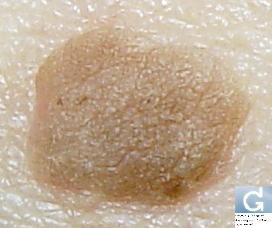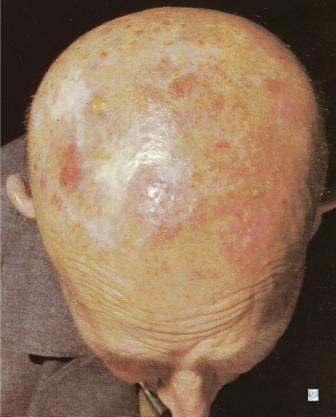Tumours and Birthmarks on the Scalp
Dr Christophe Hsu – dermatologist. Geneva, Switzerland
Naevus Sebaceous
- Naevus sebaceous are birthmarks originating from the oil glands of the skin.
- They are present at birth, initially as a faint yellowish patch that becomes raised and rough and wart-like as the child grows older. It usually appears on the scalp, but can occur on the face and neck occasionally.
- The lesion is asymptomatic.
- It often enlarges at puberty, and there is a very small risk of cancer developing on the birthmarks during adulthood.
- Surgical removal is the treatment of choice.
Seborrhoeic Keratoses (Seborrhoeic Warts, Age Spots)
- These are benign growths on the scalp or on any part of the body.
- They appear as discrete, sharply demarcated brownish to black patches or raised flat-topped lumps of various sizes. They have a smooth or rough surface. The lesions often appear on the face, but some may occur on the scalp.
- They usually occur in older adults and are very common in persons over 50 years old.
- These lesions are benign and not associated with any symptoms.
- They do not need treatment but can be destroyed and removed by liquid nitrogen applications, electrosurgery or shave excision or laser surgery for cosmetic reasons or for diagnostic concerns.

Seborrhoeic keratosis
Solar Keratoses
- Solar keratoses are pre-cancerous skin lesions on sun-exposed skin of the face and scalp.
- On the scalp they occur on balding individuals where chronic sun exposure occurs . They are often seen in fair skinned individuals who have had exposure to sunlight for many years.
- They often occur in middle-aged and older individuals. Solar keratoses present as ill-defined red scaly patches on the skin. The surface of the lesion looks and feel rough (akin to fine sandpaper).
- The lesion is painless and not itchy.
- If left untreated solar keratosis may develop into skin cancer. Solar keratoses must be destroyed to stop cancerous transformation. It is usually destroyed with liquid nitrogen applications or topical anticancer cream e.g. 5-fluorouracil. Patients with solar keratoses must avoid further sun exposure. Patients should avoid mid-day sun exposure and use sunscreen cream daily and should consult their doctor regularly to get treatment whenever new lesions occur.
- A skin biopsy may be necessary to ascertain if a cancer has developed.

Actinic or solar keratoses
Angiosarcoma
- This is a rare blood vessel cancer of the skin.
- It usually occurs in elderly patients, and it commonly presents as single or grouped bluish-red nodules or plaques on the scalp, face or ears.
- The lesions may occasionally be mildly tender but are often painless.
- Early diagnosis is essential to improve the prognosis of such patients. A skin biopsy is essential to confirm the diagnosis.
- Patients with angiosarcoma are referred to the oncologist for treatment. Localised lesions can be removed by surgery, but large lesions need radiotherapy.
- The prognosis of angiosarcoma is poor generally.
Contributors:
Dr Christophe HSU – dermatologist. Geneva, Switzerland
National Skin Centre. Singapore
Category : actinic keratosis - Modifie le 11.29.2009Category : age spot - Modifie le 11.29.2009Category : angiosarcoma - Modifie le 11.29.2009Category : Angiosarcome - Modifie le 11.29.2009Category : crasse sénile - Modifie le 11.29.2009Category : kératose actinique - Modifie le 11.29.2009Category : Kératose séborrhéique - Modifie le 11.29.2009Category : Névus sébacé - Modifie le 11.29.2009Category : nevus sebaceous - Modifie le 11.29.2009Category : Seborrheic keratosis - Modifie le 11.29.2009Category : Seborrhoeic keratosis - Modifie le 11.29.2009Category : taches de vieillesse - Modifie le 11.29.2009


